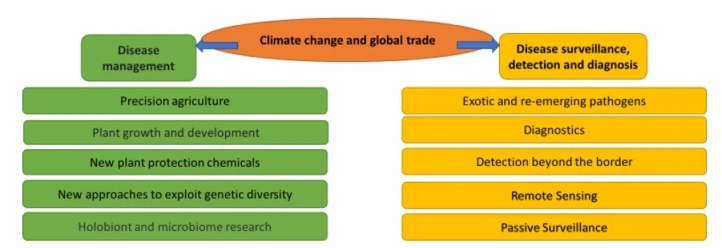Plant pandemics have been forecasted as the next big contagion and posing threats to global food security.
|
Major Pandemic Plant Diseases and Outbreak |
|||
|
Disease |
Pathogen |
Origin |
Outbreak |
|
Wheat blast disease |
Mangalore oryzae Triticum (Moot) - Fungus |
South America - Brazil |
In Bangladesh in 2016 and 2018 outbreak in South Africa and Zambia |
|
Banana Fusarium Wilt |
Fusarium oxysporum - Soil fungus |
Central America |
By 1960, it spread to tropical America, the Caribbean and West Africa |
|
Fusarium Tropical race 4 |
Taiwan, East Asia |
Spread to 20 countries, including India |
|
|
Maize lethal necrosis |
Combination of 2 viruses—maize chlorotic mottle virus (MCMV) & sugarcane mosaic virus (SCMV) |
United States in the 1970s. |
Now prevalent in Rift valley region East Africa, Southeast Asia, and South America. |
|
Coffee leaf rust |
Fungus Hemileia vastatrix |
East Africa |
Spread to all coffee cultivation areas in Asia, the Americas and Africa |
|
Cassava brown streak |
Cassava brown streak virus |
Tanzania in 1935 |
Now spread to central and southern Africa. |
|
Late blight disease - Tomato & potato |
Fungus Phytophthora infestans |
|
In India, the disease continues to cause outbreaks since the 1800s. |
|
Citrus tristeza disease |
Closterovirus |
First recorded in Argentina in the 1930s |
Spread to South Africa, West Africa and California |
Fungal disease outbreak could reduce global wheat production by 13% by 2050.
|
Impact of Climate Change in Plant Pandemic |
|
Pierce’s disease is a bacterial disease that affects grapevines and can cause epidemics in vineyards of southern Europe, particularly in France, Italy and Portugal.
Magnaporthe oryzae Triticum (MoT), a fungus that attacks wheat crops and can wipe out the entire harvest in a matter of days.
|
Measures by India to Tackle |
|
